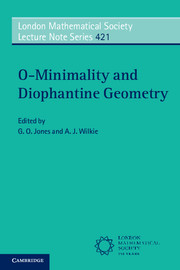Book contents
- Frontmatter
- Contents
- Preface
- 1 The Manin-Mumford Conjecture, an elliptic Curve, its Torsion Points & their Galois Orbits
- 2 Rational points on definable sets
- 3 Functional transcendence via o-minimality
- 4 Introduction to abelian varieties and the Ax–Lindemann–Weierstrass theorem
- 5 The André-Oort conjecture via o-minimality
- 6 Lectures on elimination theory for semialgebraic and subanalytic sets
- 7 Relative Manin-Mumford for abelian varieties
- 8 Improving the bound in the Pila-Wilkie theorem for curves
- 9 Ax-Schanuel and o-minimality
6 - Lectures on elimination theory for semialgebraic and subanalytic sets
Published online by Cambridge University Press: 05 August 2015
- Frontmatter
- Contents
- Preface
- 1 The Manin-Mumford Conjecture, an elliptic Curve, its Torsion Points & their Galois Orbits
- 2 Rational points on definable sets
- 3 Functional transcendence via o-minimality
- 4 Introduction to abelian varieties and the Ax–Lindemann–Weierstrass theorem
- 5 The André-Oort conjecture via o-minimality
- 6 Lectures on elimination theory for semialgebraic and subanalytic sets
- 7 Relative Manin-Mumford for abelian varieties
- 8 Improving the bound in the Pila-Wilkie theorem for curves
- 9 Ax-Schanuel and o-minimality
Summary
During the Fall Semester of 2010 I gave a course of lectures at the University of Illinois at Chicago, repeated at the University of Notre Dame, to the graduate students in Logic, and these are the notes of that course. I am extremely grateful to David Marker and Sergei Starchenko for the invitations, and for their kind hospitality during my visit. Many thanks also to the students for typing up the notes, which had remained in scruffy hand written form since I first gave a version of the course to the Logic Advanced Class in Oxford during the Trinity Term of 1994.
My intention in these lecture notes is to present all the mathematical background required for the proof of the quantifier elimination theorem of Denef and van den Dries for the structure Ran in a language with a function symbol for division. Of course, I also give the proof of the theorem itself and here I experimented with using the model theoretic embedding criterion for quantifier elimination rather than following the original paper. However, I now feel that any improvements are minimal and cosmetic.
The prerequisites are, I hope, just a working knowledge of undergraduate algebra and analysis and an introductory graduate course in model theory. So I present the theory of Noetherian rings up to the Artin-Rees Lemma and the Krull Intersection Theorem on the algebraic side, and the basics of convergent power series and analytic functions up to the Weierstrass Preparation Theorem on the analytic side. The two sides come together in the proof of the deepest mathematical result used by Denef and van den Dries, namely the flatness of the ring of convergent power series in the ring of formal power series. (In fact, only the linear closure (and for just one linear equation) of the former ring in the latter is actually needed, so I do not need to mention the general notion of flatness, and thereby avoid a discussion of tensor products.)
Information
- Type
- Chapter
- Information
- O-Minimality and Diophantine Geometry , pp. 159 - 192Publisher: Cambridge University PressPrint publication year: 2015
Accessibility standard: Unknown
Why this information is here
This section outlines the accessibility features of this content - including support for screen readers, full keyboard navigation and high-contrast display options. This may not be relevant for you.Accessibility Information
- 1
- Cited by
